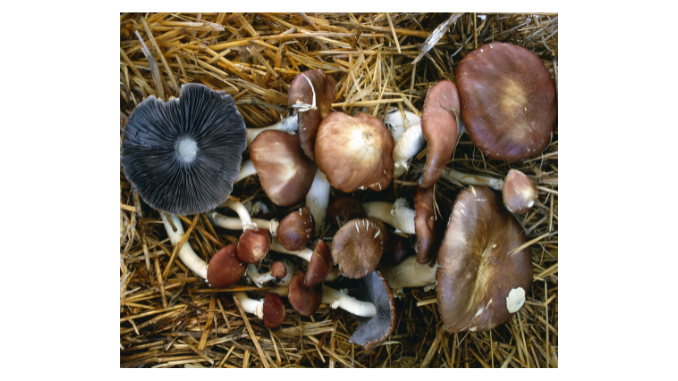Know in one minute about Stropharia rugosoannulata
|
Introduction
Stropharia rugosoannulata is a valuable edible mushroom that belongs to the Strophariaceae family. This mushroom is one of the top ten mushrooms traded internationally. Cultivated commercially for food. Stropharia rugosoannulata gains popularity and is even recommended by United Nations Food and Agriculture Organization (FAO) due to its delicious taste and health benefits. It has a refreshing, slightly sweet taste with a delicate fragrance and a crisp texture. It is a grass-rotting mushroom, found in gardens, parks, and grasslands and can even grow on manure.
The wine cap is a large mushroom and can grow up to 20 cm tall with a flattening cap up to 30 cm across. It is slightly sticky and has Burgundy red-wine to dark reddish-brown caps when young and fresh. The color fades from brown to white, becoming smooth, dry, and cracked as the mushroom matures. The gills are white or pale at first, then turning gray to dark purple-brown with maturity. This mushroom stem is long, thick with white flesh, and contains a wrinkled ring on the upper stalk (1).
Common name
Wine-cap mushroom
Wine Cap Stropharia
King Stropharia,
Winter mushroom
Garden giant
Wine Roundhead
Burgundy mushroom
Godzilla mushroom
Saketsubatake (in Japanese)
Geographical distribution
This mushroom is widely found in Europe, North America, and Asia, and has now been introduced to Australia, New Zealand, and South America.
Nutritional value of Stropharia rugosoannulata
Stropharia rugosoannulata has high nutritional value and medicinal properties. It contains a high amount of protein, carbohydrate, fiber, and minerals, with low content of fat and sodium/potassium ratio.
The amount of protein and micronutrient minerals is higher in this mushroom than in button mushrooms, shiitake, and oyster mushrooms.
They are also rich in polysaccharides, triterpenoids, and reducing sugars, which add great medicinal value to this mushroom (2).
Health benefits
1. Rich in nutrients
Stropharia rugosoannulata has high carbohydrates, proteins, fibers, and minerals with low content of fat and sodium/potassium ratio. Thus this mushroom is suitable for people with a low-fat healthy diet (3).
2. Antioxidant properties
Polysaccharides found in Stropharia rugosoannulata mushrooms act as potent natural antioxidants that remove harmful radicals from the body. Thus the intake of this mushroom protects the body from various diseases (4).
3. Keep bone healthy
The osteoclast is a large bone cell that breaks down or dissolves the bone. The abnormal acceleration of osteoclast may cause osteoporosis, however, Stropharia rugosoannulata contain sterols that suppress osteoclast formation and strengthen the bones (5).
4. Antifungal properties
Systemic candidiasis is a serious Candida infection that is caused by an immune deficiency and affects many organs. However, Stropharia rugosoannulata exerts antifungal actions against Candida albicans and prevents infections.
5. Antibacterial properties
Srophoria rugsoannulata contains biologically active substances that fight against different bacteria and prevent various infections. It inhibits bacteria like Escherichia coli, Streptococcus pneumonia, Pseudomonas aeruginosa, Salmonella typhimurium, and Klebsiella pneumonia.
6. Treat brain disease
The cell endoplasmic reticulum stress can cause the death of normal brain cells and further cause degenerative diseases like Alzheimer’s disease.
The sterols found in Srophoria rugsoannulata protect the brain cells by easing the stress thus treating brain disease (6).
7. Ease cancer
A protein known as lectin in Srophoria rugosoannulata mushroom inhibits the growth of cancer cells and is effective against HIV infection. Thus, this mushroom may develop into a cancer therapy agent (7).
8. Lower cholesterol level
Stropharia rugosoannulata contain a polysaccharide that decreases the bad cholesterol and increases the good cholesterol level in the blood (8).
9. Treat diabetes
Polysaccharides from Stropharia rugosoannulata decrease the plasma glucose level in the blood. It corrects the liver function by promoting insulin synthesis thereby reducing the blood glucose level. Thus, intake of this mushroom manages diabetes (9).
Side effects
Wine cap mushroom has no side effects in moderate amounts but the person who has any mushroom allergy should avoid it. Moreover, it contains hallucinogenic compounds that may cause visual illusions, euphoria, and dizziness. Thus it is best not to eat a high amount for a longer time to avoid problems (10).
How to cook / recipes
Wine cap mushrooms can be cooked in various ways like braising, grilling, and sautéing. They can be added to soup, pasta, cakes, sauces, or risotto. After cooking, they are crisp, crunchy, meaty texture with a mild, earthy, and nutty taste that slightly potato and red wine notes.
Furthermore, like other mushroom wine cap mushroom can be easily stored in a paper bag in the refrigerator. However, they are highly fragile due to their high water content and high respiration rate thus keeping up to a week (11).
